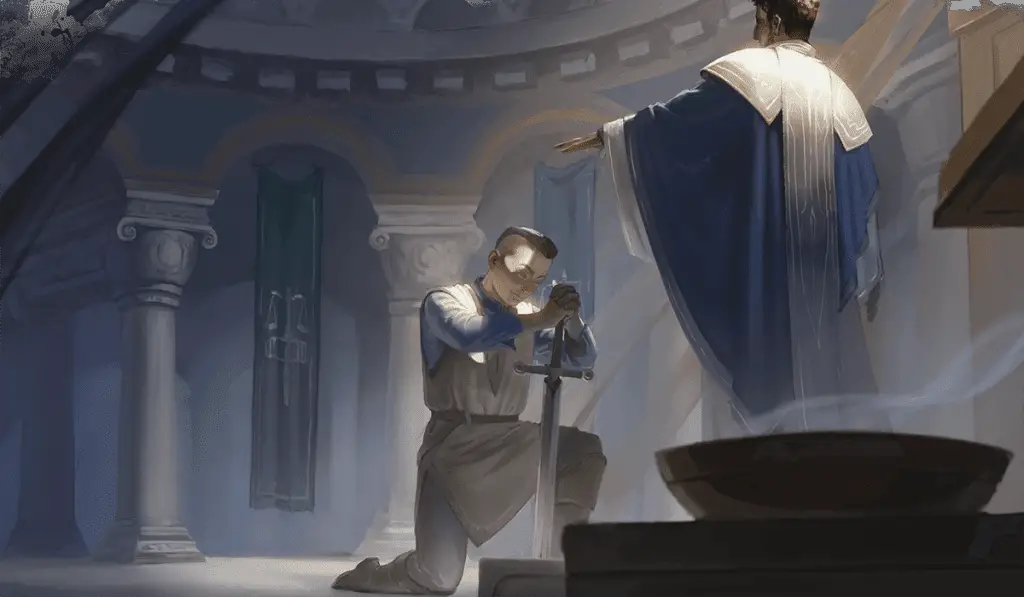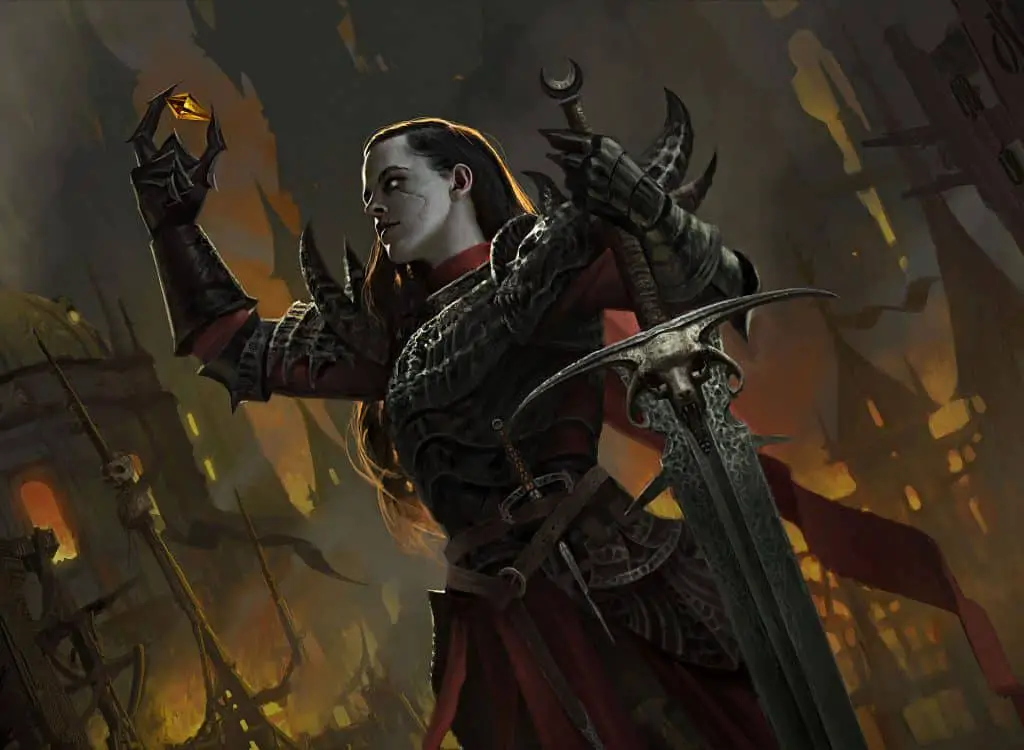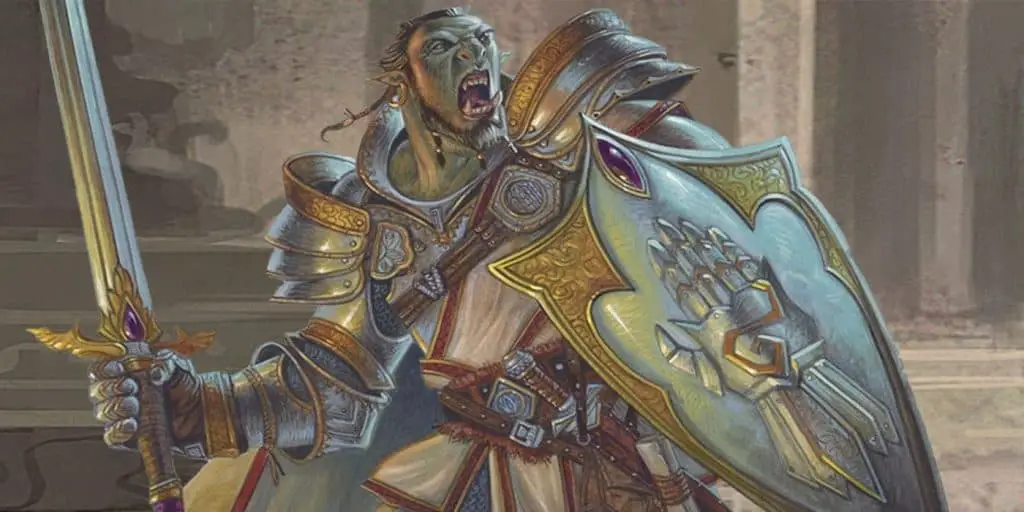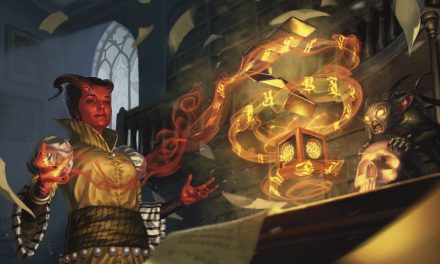Paladins are powerful warriors who blend martial prowess and divine magic to devastating effect.
Swearing an Oath and dedicating their life to upholding it, Paladins temper their might with a strong set of principles.
While all Paladins may share some similarities, most of the Oaths are radically different from each other. Some Paladins may swear themselves as noble defenders while others aim to become champions of the Gods or mighty conquerors.
But what is the best Paladin subclass? After all, if you’re going to swear yourself to a Sacred Oath it makes sense to choose a good one!
In this article, we’re ranking every Paladin subclass in D&D 5e.
While we will touch on the theme and style of each subclass, it doesn’t have an effect on these rankings.
Instead, we’re focusing on an “apples to apples” comparison. Specifically, we’re looking at each subclass’s mechanics, the impact it has on the game, and how powerful it is in general situations.
Which Paladin subclass will take the number 1 spot?
Find out now!
Number 9 – Oath of the Crown

The Oath of the Crown is sworn by elite Paladins who have sworn themselves to protecting their rulers and nation.
These Paladins favor a strongly defensive playstyle which is reflected in their spells and features.
Rallying those around them, Oath of the Crown Paladins can use their Channel Divinity to prevent enemies from fleeing or heal all their nearby allies.
Using their Divine Allegiance feature, these Paladins can take damage in place of their allies.
As for their spells, gaining the very powerful Spirit Guardians spell is a hugely compelling reason to play an Oath of the Crown Paladin. Mixed with their ability to zone and control enemy positioning, it can be devastating!
The main thing that knocks the Oath of the Crown Paladin down to this spot is its Divine Allegiance feature. It’s pretty much this subclass’s core feature as a defender.
The feature itself isn’t bad. It’s just that the Oath of Redemption Paladin came along, took the same feature, and made it better.
The Oath of the Crown Paladin is not necessarily a bad choice, but it does take last place in this ranking.
Protect your King and country with the full guide to the Oath of the Crown Paladin!
Number 8 – Oath of Glory

Pulling from the themes and aesthetic of the Ancient Greek legends, we have the Oath of Glory Paladin.
The idea behind this subclass is that those who swear this Sacred Oath dedicate themselves to mastering their body, mind, and spirit. They know that one day the Gods will call on them for a grand quest that will become legendary and want to be ready for when that time comes.
As such, this subclass focuses heavily on athleticism and momentum. Not only are Glory Paladins seeking glory for themselves, but they seek to raise others along with them.
Passing temporary hit points to their allies after landing a Divine Smite and increasing the party’s movement speed, the Oath of Glory hits hard and fast.
There are only a couple of things pushing the Oath of Glory Paladin lower in this ranking.
Using their Channel Divinity to boost their athletic prowess is cool but a bit more niche in its application. If you need to leap over a chasm or lift something incredibly heavy, it’s useful but that probably won’t happen all the time.
Second, they have a spell list with several good or decent options but many of those spells require concentration. Since you’re on the frontlines, you basically need to take the Resilient (Constitution) feat for them to have any real impact.
The Oath of Glory Paladin has one of my favorite themes on this list, but it suffers a bit mechanically.
Reach physical perfection with the full guide to the Oath of Glory Paladin!
Number 7 – Oath of Devotion

The Oath of Devotion Paladin is perhaps the truest idea of what a Paladin even is.
In service to their deity, these warriors protect those around them and vow to stand against evil. They are a light in the darkness and act with honesty, courage, and honor.
As holy warriors, Devotion Paladins are particularly excellent at fighting undead and fiends. In a campaign with plenty of these types of enemies, the Devotion Paladin would rank much higher on the list.
Devotion Paladins can use their Channel Divinity to send undead and fiends running for the hills with their Turn the Unholy option. They can also use the Sacred Weapon option for their Channel Divinity to add their Charisma modifier to attack rolls they make with their weapon.
Their Aura of Devotion makes them and their nearby allies immune to charms which can be incredibly useful to have. Meanwhile, their spell list offers some good defensive utility.
While Devotion Paladins specialize in taking on unholy enemies like fiends and undead, that also limits them a bit on this ranking.
It’s unreal how many times I’ve swapped the Oath of Glory back and forth with the Oath of Devotion Paladin for this article. But fiends and undead tend to be common enough that you’ll likely get some extra moments to shine as a Devotion Paladin in nearly any campaign.
Considering that, the Oath of Devotion Paladin takes the number 7 spot in this ranking!
Find your higher calling with the full guide to the Oath of Devotion Paladin!
Number 6 – Oath of the Watchers

Speaking of more specialist-type subclasses, the Oath of the Watchers Paladin takes the number 6 spot!
These Paladins are sentries who take a stand against threats and beings from beyond the Material Plane.
Creatures like aberrations, elementals, fiends, and Fey can cause untold damage just by their very presence. Even celestials are watched closely and with suspicion from the Oath of the Watchers Paladins!
Between their spell list and subclass features, it’s very difficult to trick or otherwise bamboozle an Oath of the Watchers Paladin. Of the tenets of their Sacred Oath, vigilance stands firmly at the top!
Banishing extraplanar creatures back to where they came from and sending those creatures running (as with the Devotion Paladin’s “Turn the Unholy” feature) are firmly within these Paladins’ wheelhouse.
Against those who are fond of mental tricks, the Watchers Paladin can steel their allies against mental saving throws.
Though their Aura of the Sentinel which gives the Watchers Paladin and their allies a bonus to initiative rolls is particularly amazing!
If a campaign involves a lot of extraplanar threats (like Mind Flayers, elementals, or invading fey/fiends), the Oath of the Watchers rockets to the top of the list.
However, in a campaign that doesn’t feature many of those types of enemies, it’s not quite as engaging to play.
Stand vigilant with the full guide to the Oath of the Watchers Paladin!
Number 5 – Oath of Conquest

With conquering military might, the Oath of Conquest Paladin takes the number 5 spot on this list.
True to their name, these Paladins are incredibly aggressive combatants who focus on entirely destroying and subjugating their enemies. They value strength and seek to inspire fear in their enemies before they have even drawn their weapons.
Conquest Paladins have a strong spell list that is suited to what they do best.
Armor of Agathys gives them a defensive buff that also hurts enemies. Spells like Spiritual Weapon increase their damage output while options like Command and Dominate Person are used to establish their authority.
But where the Oath of Conquest Paladin excels is in causing fear in the hearts of their enemies.
Using their spells or Channel Divinity, these Paladins can frighten enemies like there’s no tomorrow. Combining this with their Aura of Conquest, enemies are terrified and left unable to move while they take automatic damage at the start of each turn.
Oath of Conquests don’t really hit their stride until they hit level 9, but all bets are off when they do. But even before that, they’re still offensive powerhouses.
If you’re looking for an offense-oriented Paladin subclass with good amounts of battlefield control, the Oath of Conquest might be for you!
Crush your enemies with the full guide to the Oath of Conquest Paladin!
Number 4 – Oathbreaker

Those who break their oaths and do not atone might find themselves called towards the darkness. Should they succumb to this temptation, they become an Oathbreaker.
Tucked away in the Dungeon Master’s Guide, the Oathbreaker Paladin is more intended for villainous NPCs. However, it might be allowed as a player option which is why it is on this list.
And what an option it is!
The Oathbreaker is a very strong Paladin subclass. Their spells and features are meant to keep their foes locked down and helpless. Gaining undead minions and buffing them with the aptly named Aura of Hate, the Oathbreaker can easily ruin their enemies’ day.
Similar to the Conquest Paladin, there’s a big focus here on frightening enemies and then swiftly punishing them.
I’m not going to lie, the Oathbreaker Paladin makes a compelling argument for joining the side of evil.
While an Oathbreaker won’t really fit in with the vast majority of campaigns, it’s impossible to deny how strong it is.
Just be aware that their Aura of Hate buffs all the fiends or undead near you regardless of whether they’re you’re minion or not. If you are playing an Oathbreaker Paladin and find yourself up against some of these enemies, you’ll be buffing them as they try to hurt you!
Turn to the dark side with the full guide to the Oathbreaker Paladin!
Number 3 – Oath of Redemption

All this talk of conquest, hatred, and the undead is really killing the vibe, huh? Maybe it’s time to mellow out a bit.
Taking it easy and chilling at the number 3 spot, we have the Oath of Redemption Paladin.
These Paladins are powerful defenders, healers, and supporters for their party. Swearing a Sacred Oath of peace, understanding, and patience, they are firm pacifists.
Sanctuary, Counterspell, Resilient Sphere, and Wall of Force are just a few standout defensive spells on the Oath of Redemption Paladin’s spell list.
Using their Channel Divinity, Redemption Paladins can gain a bonus to their Persuasion checks or force enemies to take as much damage as they’ve just dealt.
Though the standout feature for the Redemption Paladin is their Aura of the Guardian. It’s a better version of the Oath of the Crown’s feature in which the Paladin can take on damage instead of their nearby allies.
Once these Paladins level up, they’ll also gain a passive healing ability which works great with their Aura feature.
Mechanically, the Oath of Redemption Paladin is an incredibly powerful subclass option. They have a clear role in the party and do it very well.
As for how to play a pacifist character in a game like D&D, that’s a different issue.
The theme of pacifism is nice and all, but difficult to do well in most D&D games. It definitely works best with a specific type of party in a specific type of campaign.
But since we’re strictly talking about the mechanics and impact of Paladin subclasses in this ranking, the Oath of Redemption ascends into the top 3!
Embrace the way of peace with the full guide to the Oath of Redemption Paladin!
Number 2 –Oath of the Ancients

Blossoming into the number 2 spot in this ranking, we have the Oath of the Ancients Paladin.
Functioning as a type of hybrid between the Paladin class and Druids or Rangers, these Paladins work tirelessly to preserve all that is good in the world. They might also be called Green Knights, Fey Knights, or Horned Knights because of their armor adornments.
The Sacred Oath that these Paladins swear is older than any mortal creature could remember.
The Oath of the Ancients prizes light as the power that allows for growth and encourages kindness, merriment, and creation. However, it also emboldens Paladins to do whatever it takes to stand against the darkness that would threaten that light.
These Paladins’ spell list is very nature-based with inclusions such as Ensnaring Strike, Speak with Animals, and Plant Growth. Though Misty Step is particularly a standout inclusion for both engaging and disengaging!
Oath of the Ancients Paladins are formidable melee combatants that also have access to several spells and features allowing them to better control the battlefield.
Their Aura of Warding is immensely impactful if you’re going up against spellcasters that are fond of damage spells. Giving yourself and your allies resistance to spell damage means you’ll be able to laugh off spells like Fireball.
Whether you’re a new player or D&D veteran, the Oath of Ancients is incredibly accessible and impactful for any party!
Become nature’s champion with the full guide to the Oath of the Ancients Paladin!
Number 1 – Oath of Vengeance

Standing tall at the number 1 spot of this ranking we finally come to the Oath of Vengeance Paladin.
While there are many excellent Paladin subclasses to choose from, this just has to take the top spot. There is just so much to love here!
As the name says, these Paladins have sworn an oath to right the wrongs that have been inflicted on themselves or others.
The spells on the Vengeance Paladin’s list are fantastic. Misty Step makes for some reliable movement and Hunter’s Mark can help you deal even more damage to whoever has earned your wrath.
Though, of course, we can’t forget the awesomeness that is the Haste spell. Combining Haste with this Oath’s features is simply terrifying.
But the real star of the show with the Oath of Vengeance Paladin’s features is Vow of Enmity.
For 1 minute, Vow of Enmity gives you advantage on all attack rolls against the creature you’ve chosen. That’s 10 rounds of getting advantage on all of your attacks!
Used against a boss, this might as well just be called “I win.”
The rest of the Vengeance Paladin’s features are all about giving you even more attacks and mobility.
Oath of Vengeance Paladins start out incredibly strong and only continue to get even stronger as they level up with no real lull in their development. You’re basically the Juggernaut.
When it comes to sheer offensive power, it’s hard to match the Oath of Vengeance Paladin. Not only are they hands-down the best Paladin subclass, but they’re one of the strongest subclasses in all of D&D 5e!
Serve up some revenge with the full guide to the Oath of Vengeance Paladin!
Conclusion – Ranking Every Paladin Subclass in D&D 5e
But that’s pretty much it for this ranking of every Paladin subclass in D&D 5e!
What are your thoughts? Would you rank the subclasses differently? Let’s chat in the comments!
This was one of the harder rankings I’ve done. There really aren’t any explicitly bad subclass options for Paladins in D&D 5e. Depending on what type of campaign you’re playing or your party dynamic, any one of these could really shine.
And don’t forget to sign up for the Tabletop Joab newsletter! It’s the best way to get all the latest player guides, DM Tips, news, reviews, and more for D&D right to your inbox!
You can find the Oath of Devotion, Oath of the Ancients, and Oath of Vengeance Paladins in the Player’s Handbook.
The Oath of Conquest and Oath of Redemption Paladins are in Xanathar’s Guide to Everything.
Find the Oath of Glory and Oath of the Watchers Paladins in Tasha’s Cauldron of Everything.
The Oath of the Crown Paladin appears in the Sword Coast Adventurer’s Guide.
You can find the Oathbreaker Paladin near the back of the Dungeon Master’s Guide.









